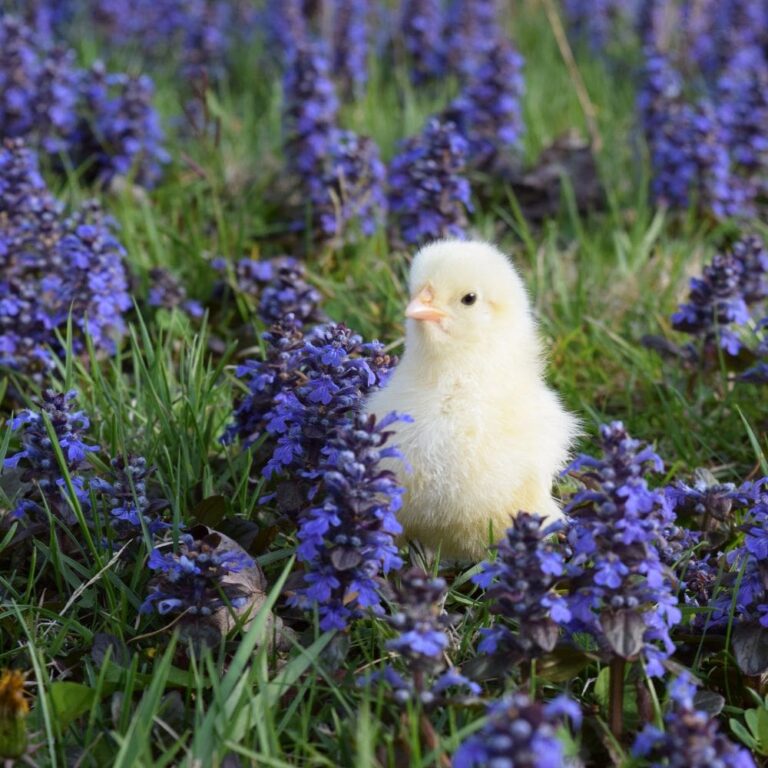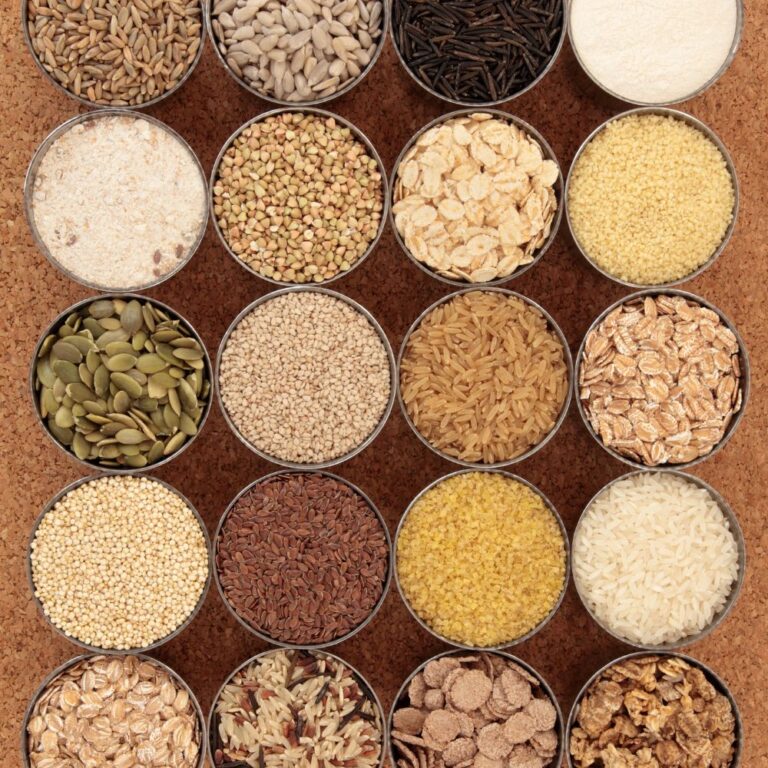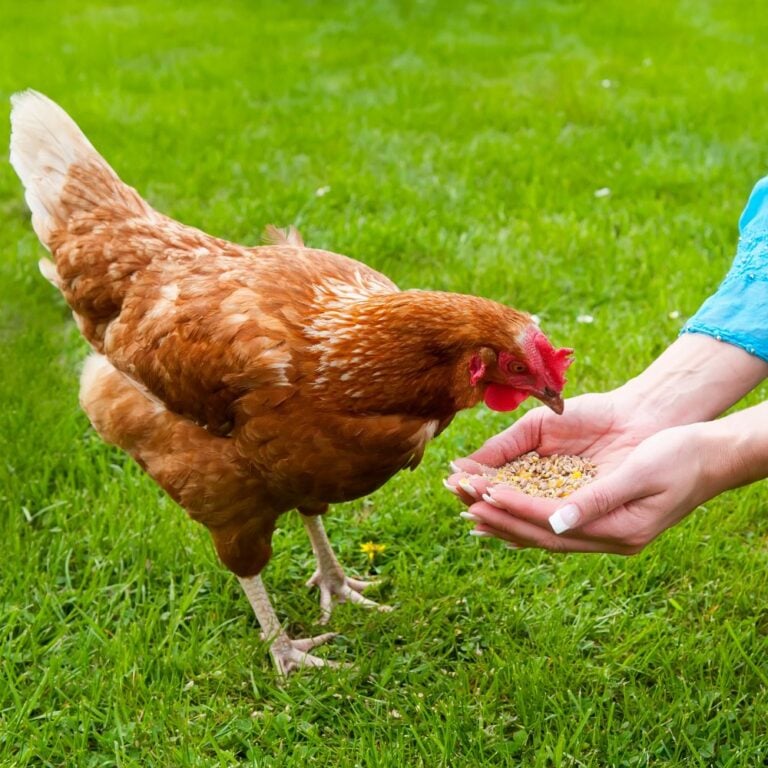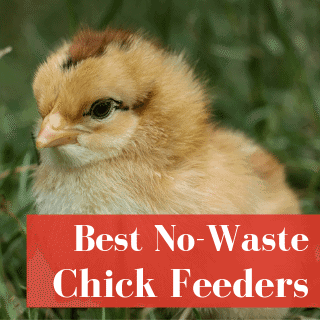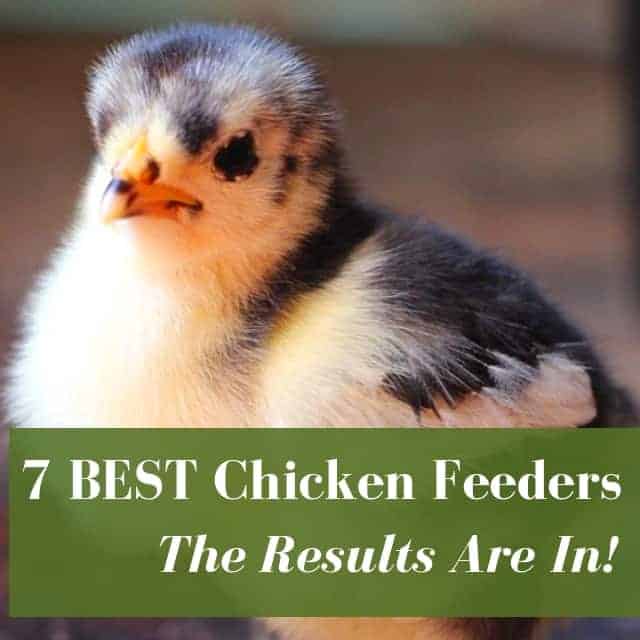A chicken’s gotta eat, right? Especially if they’re layers. They must also have the calcium required to put the shells on their eggs. The trick is finding ideas to feed a flock so every chicken gets food. How can that be done?
In this article, you’ll discover some ways you can make sure each and every one of your chickens eats enough so they’re healthy. Here are our best tips to help ensure that each chicken is filling their belly!
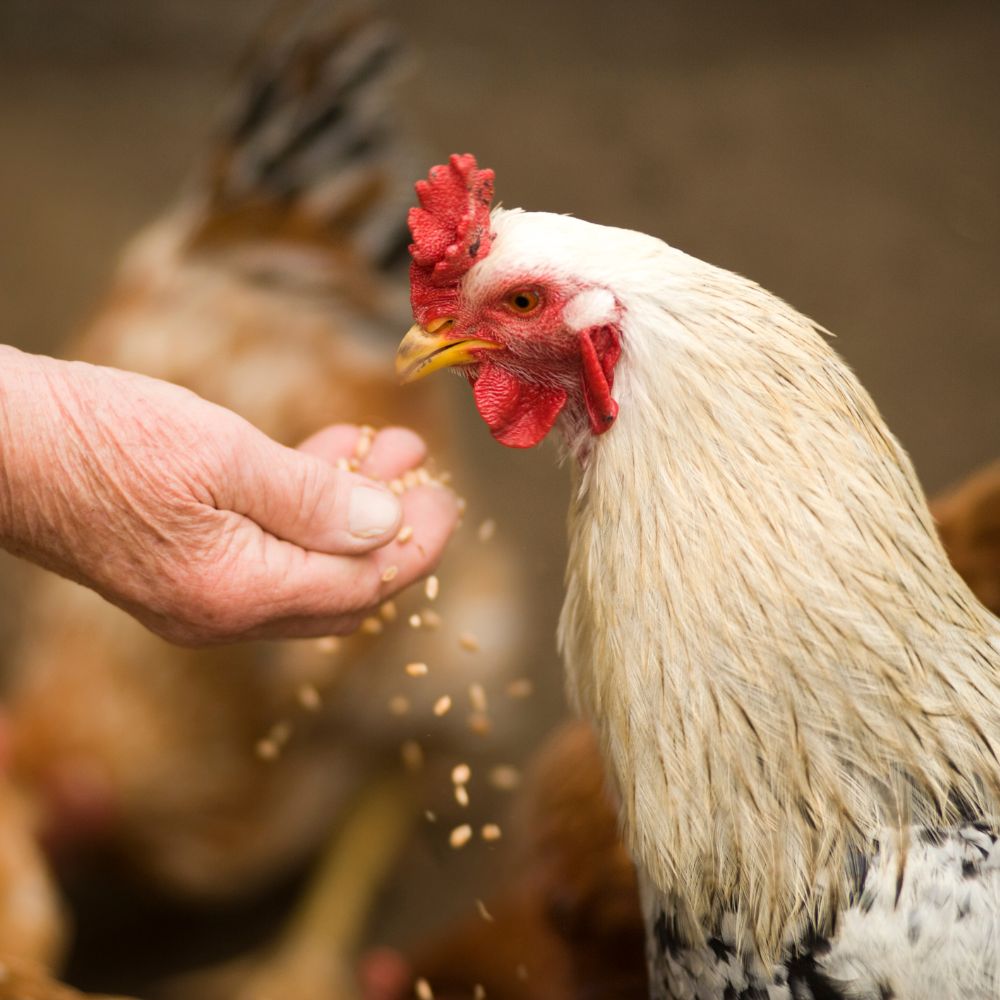
Table of Contents (Quickly Jump To Information)
How Much Food Do Chickens Need?
For reference, one adult hen or rooster eats roughly 1/4 pound of feed per day. This amounts to about 1.5 pounds per week. For hens, you’ll want to provide a high-quality layer feed (this is the feed we use). It should be a complete feed, meaning it has the right amount of protein, vitamins, and minerals so your chickens stay strong.
For pullets (female chickens that aren’t laying eggs yet), you should feed a 16% grower feed or you can continue feeding their 18% protein chick starter feed (this is the chick starter we feed because it has herbs).
For layers, it’s also very important to provide a calcium supplement. According to the Merck Veterinary Manual, “laying birds require 3.5%–6% calcium because of the nutritional demand for laying eggs (a typical egg requires ~2 g of calcium).” You can easily provide extra calcium with oyster shells, or even eggshells. This is an excellent source of calcium.
Keep track of how much your chickens are eating. If you go to check on them, and there’s significantly less feed being eaten by the flock, it could indicate a problem. You can learn more about feed here.
If your backyard chickens forage they will get to eat a lot of bugs and that will give them extra protein. But even if your chickens free-range or get your left over kitchen scraps and vegetables, they still need a balanced feed to ensure proper nutrition.
Signs Your Hens Aren’t Eating Enough
Some obvious signs your chickens aren’t eating enough include:
- Low weight/Easy-to-feel bones
- Pronounced keel bone
- Reduced egg production
- Abnormal eggs
- Disheveled feathers
- Depressed personality
- Keeping eyes closed
Low weight/Easy to feel bones
If you’ve noticed your hens have lost weight – maybe you pick them up, and they feel lighter, or you suddenly notice you can feel their thigh bones through their skin – it’s possible they aren’t eating enough.
You might wonder how much your chicken should weigh. Truthfully, it depends on the breed. For example, Mille Fleurs weigh about 2-3 pounds, while Jersey Giants can weigh 10 pounds. In this article, you’ll discover the average weight for most chicken breeds. You can print it out and keep it handy.
It’s always a good idea to keep records of how much your chickens weigh. Assuming they’re in good health, weighing your chickens monthly should be enough (if they’ve been sick, and you’re trying to get weight back on them, then you might opt to weigh them weekly.)
Pronounced keel bone
I personally use the keel bone (also called the breast bone) to keep an eye on my flock. If I pick up a hen and notice her keel bone is pronounced, she goes on a high fat/high protein diet (for example, black soldier fly larvae) until her weight is ideal.
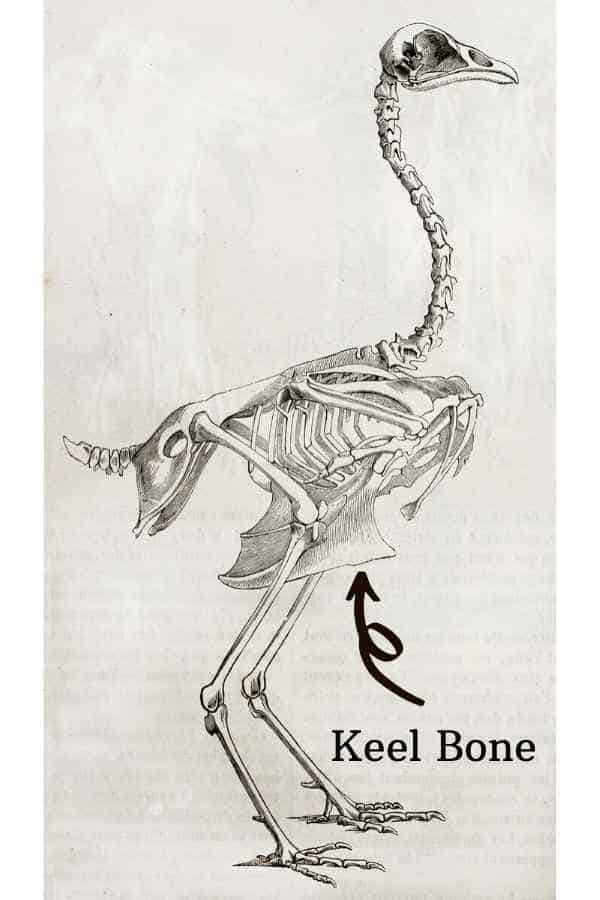
How should the keel bone feel? Like there’s some padding on each side of it. You should still feel the bone itself, but it shouldn’t feel like there’s a dramatic dip on either side. If my hen “just feels bony” in that area, I get concerned. It’s a quick and easy test to check if your flock is getting enough calories.
This is also an easy test regardless of breed. Every chicken, whether they’re a tiny Serama bantam or a huge Brahma, should have some substantial muscle on each side of their keel bone.
Reduced egg production
Sure, this is something that comes with age. And for some chicken breeds, this happens as days get shorter. But if you can’t identify any other reason why your hens might have stopped laying (you can learn about all the reasons here), then she might not be getting enough calories.
Imagine going to collect eggs from your hens on a beautiful summer day, only to find that one of them hasn’t produced anything. If it is a one-time occurrence, that’s not a huge problem. It’s something to watch, certainly. But not the end of the world. If she doesn’t lay over several days, on the other hand…you might want to bump up their feed. This is especially true if most or all of your hens stop laying.
A quick and simple fix is to offer layer feed around the clock. If you want, you can also add high protein & high fat treats.
Abnormal eggs
If your hens are laying, but the eggs are abnormally shaped, such as wrinkled or soft-shelled, or if your established laying hen lays “fairy eggs,” this could be a sign that your chickens aren’t getting the necessary nutrients. (Fairy eggs are common for brand new layers to produce, but your adult layer shouldn’t be popping them out consistently).
It takes a lot of energy to produce an egg. If your hen doesn’t get calories from her feed or from free-ranging, she runs a higher risk of laying eggs with shells that aren’t smooth. It’s time to increase her feed. You can learn more about what different weird-looking eggs mean in this in depth article.
Feather damage
Feathers are durable and tough, but damage to them is often the first indication of something that might be wrong (as long as it’s not molting season). Picking at feathers, or even out-of-season molting, could be a sign that your birds’ diets are not ideal. Additionally, if your hen has a disheveled appearance, for example, if her feathers are broken or ruffled, she might be lacking important nutrients.
Don’t confuse this with molting (although you should definitely provide a feather supplement during a molt). Chickens who lose their feathers and then regrow them can definitely look disheveled. However, this is expected and occurs in the fall/winter.
If your hen has an unkempt appearance at other times of the year, her diet might be the reason.
Depressed personality/Keeping eyes closed
Sometimes our hens seem “off.” They’re usually bright and cheerful. But if you enter their coop, and they just seem depressed and low energy, you might have a problem on your hands. Similarly, unless she’s trying to take a nap, your chicken should be interested in her environment. But if your chicken keeps her eyes closed – even after you rouse her – she might be sick.
You’ll have to rule out illness first. If the vet clears her, then try increasing how much feed you offer, especially if you feel her keel bone (using the test above). It’s possible she doesn’t feel well because she’s hungry!
How Can I Help Every Chicken In My Flock Get Food?
Observation
This is kind of a bizarre tip. But it is nonetheless important. In fact, it’s pretty critical! Before you can figure out how to help chickens who aren’t eating enough, you need to know why they’re not eating enough! So, watch your chickens for a few hours. Figure out their social structures, and diagnose the problem that’s preventing some hens from eating. If you notice there’s some flock members who aren’t able to get to their dinner, you can troubleshoot ways to ensure that everyone is fed.
For example, if you notice a very bossy hen keeps your little bantams from the feeder, you can add more feeders (more on this below).
Or, maybe you think you’re providing enough feed, but really aren’t. Maybe they run out after 10 minutes, and there’s nothing left for the weaker flock members. But you won’t know unless you observe.
You’ll also get a better understanding of the eating habits of your birds. Pay attention to the amounts of feed that you’re putting into their feeders, or distributing on the ground, and you’ll get a sense of the amounts being eaten – or worse – not being eaten.
I’ve found that observation is very important in my own coop. For example, my bantam Cochin hens love staying up in the loft in their coop. They don’t really like coming down. We used to have a lot of roosters in the coop. Staying above the crowd was safer!
Now that there are fewer roosters, they still prefer to stay above the fray at mealtimes. They just don’t like being overwhelmed. However, they don’t always eat as much as their flock mates. So, I take extra care to put a bowl of feed where THEY can access it.
Similarly, my frizzle bantams are lower on the pecking order. They can’t really fly and will crowd into a corner at mealtime. Having multiple feeders – and strategically placing them – keeps them full all the time. But if I hadn’t watched how each individual chicken acts at mealtimes, I would never know!
Only Keep As Many Chickens As You Can Reasonably Care For
This seems like an obvious thing, but chicken math is a real issue. If you suddenly end up with 100 chickens, you’ll probably have a hard time keeping an eye on all of them. Little problems can creep in and become big problems.
For example, if you have a large flock, you probably have a pretty well-established pecking order. Your alpha chickens eat first, and the more passive hens eat last. It’s also possible your bossy brood won’t allow the weaker flock members to eat at all. Yes, it happens!
Only raise as many chickens as you can reasonably keep an eye on. This goes double if you’re a busy person who doesn’t spend a ton of time at home! You must monitor their health, and do a physical check regularly.
Money is another concern. The more chickens you have, the more money it costs to feed them. If you’re on a budget, just get a few hens. You’ll have an easier time making sure everyone gets enough to eat. Nothing is worse than stressing about how to pay for a ton of chicken feed every week!
In our area, if we had to purchase a ton (literally 2,000 pounds) of feed, it would cost $200-$300 each week. And that’s from a grain mill (which typically charges a lot less), not a farm store like Tractor Supply.
Hand Feeding
Hand feeding is a fantastic way to make sure that your birds are eating, especially if you have a friendly flock. By being in control of the dispensation of grains, pellets, and goodies, you can manage exactly which chickens get what food. It’s also a great way to bond with your flock! Some treat options are layer feed, black soldier fly larvae, or other treats.

The biggest drawback to this method of feeding is time. Hand feeding is incredibly time-consuming, especially when we’re talking about large flocks of hundreds of chickens. This idea is probably best with small flocks of 3-5 chickens.
Multiple Feeders
Having multiple feeders is critical if you have a larger flock OR if you have bullies in your coop. I personally install 2 feeders for every 6 chickens. You can hang the feeders or simply use a bowl (we use a LOT of bowls because they’re easy to clean).
For wall feeders, I personally like Duncan’s feeders because they’re durable and hold a lot of feed. I also use large dog bowls, rubber livestock bowls, and feeders that hang from the ceiling. If you’re interested, you can check out our complete list of recommended feeders.
Look out for chickens who feel overly possessive and decide that the feed trough is theirs. These chickens will peck away any other birds (ducks included). In this case, a long trough or multiple dishes can certainly make it a challenge for the possessive chicken to peck everyone away.
I just distribute their layer feed among each bowl (this is the layer feed we use).
It’s also important to include some feeders that can be accessed from all sides. For example, if you use feeders that hang on the wall, your hens will only be able to eat on one side. But if you also have feeders that hang from the ceiling, your layers have multiple opportunities to eat their grain. It’s also harder for bossy chickens to chase away flock mates because they’ll probably be too busy eating their own meal.
Hanging feeders off the ground also makes it difficult for chickens to kick dirt or mud into their food (feed that drops from the container, on the other hand, is fair game for dirtying).
If that doesn’t work for your flock, you can opt for long troughs. They’re easily accessible from front and back, which ensures that each hen has enough time with the feed. You will probably have to clean them more often, but you’ll sleep better at night.
Even one-at-a-time feeders can promote even distribution of feed to all in the flock. Many are automatic or contain a pressure trigger that opens when a chicken steps on it. Over the course of a whole day, this ensures that feed is available to all.
Not sure how to add multiple feeders to a smaller coop? One way to manage limited space is by going up, rather than out. If you create a triple (or quadruple) floored loft for your birds, you could set up feeding stations on each level. The chickens might develop a favorite feeding place, and refilling their feeders might require some creativity, but overall, this would be a very creative use of space.
Whichever strategy you choose, it’s important to ensure an even dispersal of feed to all. The best feeders are those that can satisfy the needs of many birds at the same time.
Scatter Their Feed On The Ground
Owners who want their chickens to have the full free-ranging experience can opt to distribute their birds’ feed right into the earth of the pen. This encourages the hens to root, peck, and scratch, all of which are very good for them.
By spreading the distribution of feed all throughout the penned area, no single chicken can get all the goodies. Setting the flock loose in an exhausted garden can also accomplish this goal. Your chickens will tear up weeds, till the ground, and feast on any remaining produce. Chickens make for amazing gardeners – it couldn’t hurt to use them for a task they were built for!
One of the biggest drawbacks to this method is that it can be quite messy, and your chickens might eat something gross. Chickens poop a lot, and if all of their food is on the ground, some of it is bound to get pooped on. Then, in addition to healthy bits, your layers will also get some unhealthy bits.
Another drawback is bad weather. Not every backyard can be in lovely sunny 60 to 70-degree climates every day. Most yards will experience rain, possibly some snow, and both extreme heat and cold. All of this can create challenges.
Separate Chickens Depending On Age & Need
Chickens need different feeds depending on their ages and purposes (for example, chicks vs. 12-weekers vs. 2-year-olds, broilers vs. layers). If you feed your chicks along with your layers, it’s likely your birds will get the wrong food. It’s simplest to keep adults and chicks separated.
It will keep them eating the right food. Just ask any physical trainer, and they’ll tell you that what you eat is just as important as how you exercise. It is exactly the same for your chickens. It also reduces the numbers in your flock at mealtime. Smaller numbers mean more food for each individual. It ensures every bird has greater access to the feed that you’re giving them.
Similarly, if you have some bossy hens who are overweight, and some very passive hens that are more scrawny, you might want to keep them separated at mealtime. You can be sure each chicken gets exactly what they require to be healthy.
Not everyone has the space to separate their chickens depending on age. The secret is balance. Ask “What’s the best feed for all the chickens in my flock?” You’ll probably decide on a 18% grower feed, as this is a decent balance between chick needs and adult needs. The hens will need a calcium supplement (which can be supplied separately), but at least everyone gets enough food.
Variety
Just giving all of your birds chicken feed from a store can keep them eating, but it might grow old for them. Yes, this is really a thing! Imagine eating corn every day, in and out. You’d probably get bored too!
By providing small amounts of treats, you’ll distribute all sorts of goodies and entertainment. You can try hand-feeding their treats, and the variety will keep them engaged and happy. It also shows your love to them and can satisfy certain needs that otherwise might be ignored in store-bought feed. Plus, it is just plain fun interacting with your birds this way!
Final Thoughts
While this article is designed to be preventative, rather than reactionary, a wise chicken keeper knows that their flock will need constant supervision.
Chickens are incredibly social animals. Each one has their own personality, and sometimes their personalities get in the way of what is best for the flock, even in spite of your best efforts to keep them all healthy and hearty.
Hopefully, it will never get to a point where your birds are visibly suffering, but in case it does get to that point, at least you’ve got these tips to help redistribute your feed to all.
Maat van Uitert is a backyard chicken and sustainable living expert. She is also the author of Chickens: Naturally Raising A Sustainable Flock, which was a best seller in it’s Amazon category. Maat has been featured on NBC, CBS, AOL Finance, Community Chickens, the Huffington Post, Chickens magazine, Backyard Poultry, and Countryside Magazine. She lives on her farm in Southeast Missouri with her husband, two children, and about a million chickens and ducks. You can follow Maat on Facebook here and Instagram here.

